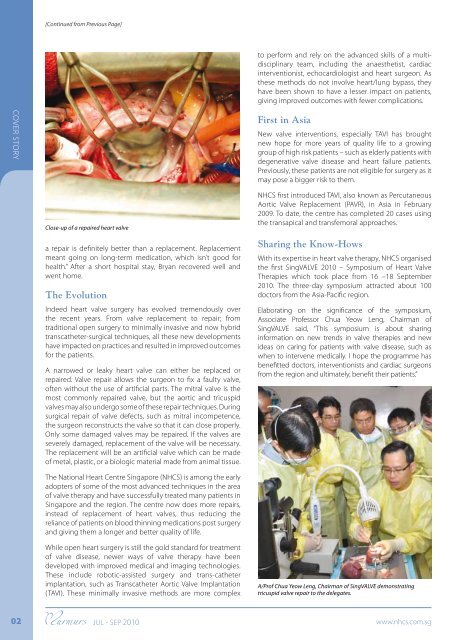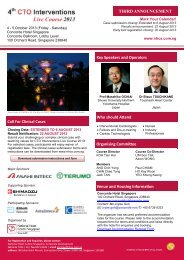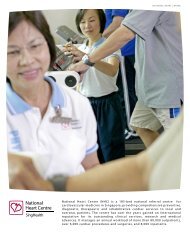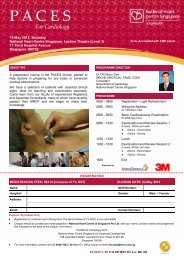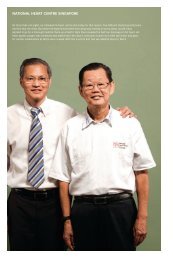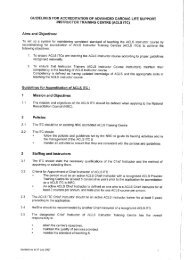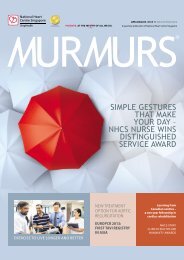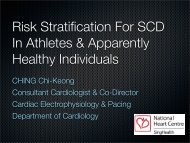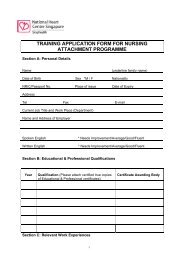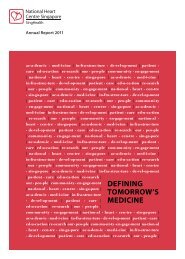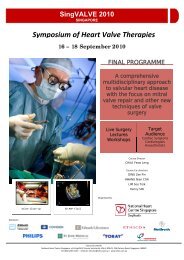Murmurs - National Heart Centre Singapore
Murmurs - National Heart Centre Singapore
Murmurs - National Heart Centre Singapore
You also want an ePaper? Increase the reach of your titles
YUMPU automatically turns print PDFs into web optimized ePapers that Google loves.
[Continued from Previous Page]<br />
to perform and rely on the advanced skills of a multidisciplinary<br />
team, including the anaesthetist, cardiac<br />
interventionist, echocardiologist and heart surgeon. As<br />
these methods do not involve heart/lung bypass, they<br />
have been shown to have a lesser impact on patients,<br />
giving improved outcomes with fewer complications.<br />
cover story<br />
First in Asia<br />
New valve interventions, especially TAVI has brought<br />
new hope for more years of quality life to a growing<br />
group of high risk patients – such as elderly patients with<br />
degenerative valve disease and heart failure patients.<br />
Previously, these patients are not eligible for surgery as it<br />
may pose a bigger risk to them.<br />
Close-up of a repaired heart valve<br />
a repair is definitely better than a replacement. Replacement<br />
meant going on long-term medication, which isn’t good for<br />
health.” After a short hospital stay, Bryan recovered well and<br />
went home.<br />
The Evolution<br />
Indeed heart valve surgery has evolved tremendously over<br />
the recent years. From valve replacement to repair; from<br />
traditional open surgery to minimally invasive and now hybrid<br />
transcatheter-surgical techniques, all these new developments<br />
have impacted on practices and resulted in improved outcomes<br />
for the patients.<br />
A narrowed or leaky heart valve can either be replaced or<br />
repaired. Valve repair allows the surgeon to fix a faulty valve,<br />
often without the use of artificial parts. The mitral valve is the<br />
most commonly repaired valve, but the aortic and tricuspid<br />
valves may also undergo some of these repair techniques. During<br />
surgical repair of valve defects, such as mitral incompetence,<br />
the surgeon reconstructs the valve so that it can close properly.<br />
Only some damaged valves may be repaired. If the valves are<br />
severely damaged, replacement of the valve will be necessary.<br />
The replacement will be an artificial valve which can be made<br />
of metal, plastic, or a biologic material made from animal tissue.<br />
NHCS first introduced TAVI, also known as Percutaneous<br />
Aortic Valve Replacement (PAVR), in Asia in February<br />
2009. To date, the centre has completed 20 cases using<br />
the transapical and transfemoral approaches.<br />
Sharing the Know-Hows<br />
With its expertise in heart valve therapy, NHCS organised<br />
the first SingVALVE 2010 – Symposium of <strong>Heart</strong> Valve<br />
Therapies which took place from 16 –18 September<br />
2010. The three-day symposium attracted about 100<br />
doctors from the Asia-Pacific region.<br />
Elaborating on the significance of the symposium,<br />
Associate Professor Chua Yeow Leng, Chairman of<br />
SingVALVE said, “This symposium is about sharing<br />
information on new trends in valve therapies and new<br />
ideas on caring for patients with valve disease, such as<br />
when to intervene medically. I hope the programme has<br />
benefitted doctors, interventionists and cardiac surgeons<br />
from the region and ultimately, benefit their patients.”<br />
The <strong>National</strong> <strong>Heart</strong> <strong>Centre</strong> <strong>Singapore</strong> (NHCS) is among the early<br />
adopters of some of the most advanced techniques in the area<br />
of valve therapy and have successfully treated many patients in<br />
<strong>Singapore</strong> and the region. The centre now does more repairs,<br />
instead of replacement of heart valves, thus reducing the<br />
reliance of patients on blood thinning medications post surgery<br />
and giving them a longer and better quality of life.<br />
While open heart surgery is still the gold standard for treatment<br />
of valve disease, newer ways of valve therapy have been<br />
developed with improved medical and imaging technologies.<br />
These include robotic-assisted surgery and trans-catheter<br />
implantation, such as Transcatheter Aortic Valve Implantation<br />
(TAVI). These minimally invasive methods are more complex<br />
A/Prof Chua Yeow Leng, Chairman of SingVALVE demonstrating<br />
tricuspid valve repair to the delegates.<br />
02 www.nhcs.com.sg<br />
Jul - Sep 2010


